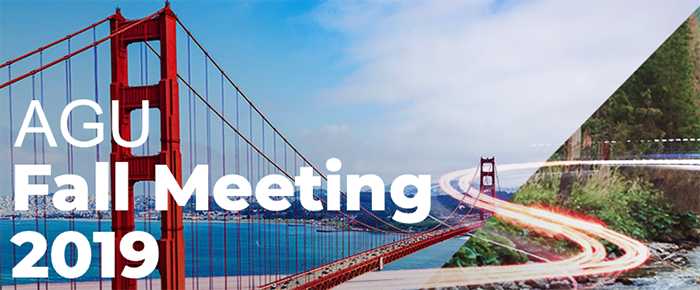GMAO Team Members, and AGU, Return to San Francisco
01.06.2020

After two years in other locations, the American Geophysical Union (AGU) Fall Meeting returned to San Francisco, CA, from December 9-13, 2019. NASA's Global Modeling and Assimilation Office (GMAO) had strong representation, with team members presenting their research through speaker panels and poster sessions ranging from moulin formation to health and air quality forecasts. Below is a list of the GMAO presenters, along with the titles of their presentations, posters and “eLightning” presentations.
Please visit https://gmao.gsfc.nasa.gov/pubs/index.php?sel=posters&yr=2019 to view PDF versions of their AGU posters.

Oral Presentations:
- Lauren Andrews — “A physical model of moulin formation and evolution in cold ice”
- Abhishek Chatterjee — “Characteristics of total column CO2 retrievals from the Orbiting Carbon Observatory missions: biases, information content and implications for flux inversions”
- Arlindo da Silva — “Lidar-Polarimeter Retrieval OSSEs in Support of NASA's Aerosols and Clouds-Convection-Precipitation (A-CCP) Study”
- Hamideh Ebrahimi — “Progress toward Implementation of Coupled Ocean/Atmosphere in Unified Forward Operator (UFO)”
- Bryan Karpowicz — “Improved ozone analyses using direct assimilation of 9.6um radiances from hyperspectral sounders”
- Jana Kolassa — “The effect of an improved dynamic vegetation phenology representation on the partitioning of transpiration and evaporation in a global land surface model”
- Emma Knowland — “Accessibility of NASA GEOS Composition Forecasts for the Health and Air Quality Communities” Presented by B. Duncan
- Andrea Molod — “MERRA-2 Ocean: The NASA Global Modeling and Assimilation Office's Weakly Coupled Atmosphere-Ocean Reanalysis”
- Tom Oda — “A suite of high-resolution atmospheric carbon dioxide simulations in support of the OCO-3 SAM map-mode observation — how should we use the OCO-3 SAM mode observation? What do we expect from the data?”
- Lesley Ott — “Understanding the influence of biogenic carbon in world cities: Implications for emissions attribution”
- Lesley Ott — “A prototype for monitoring carbon flux anomalies in near real time using NASA’s GEOS system”
- Rolf Reichle — “Global assimilation of L-band brightness temperature observations from SMAP and SMOS into the Catchment land surface model and contribution to the skill of soil moisture estimates”
- Siegfried Schubert — “A Systematic Approach to Isolating the Causes and Impacts of Climate Model Bias Employing Analysis Increments”
- Sourish Basu — “Is there an Optimal CO₂ Partial Column for Flux Inversions?”
- Kris Wargan — “Joint assimilation of the Aura Microwave Limb Sounder and Ozone Mapping and Profiler Suite Limb Profiler data: Towards a reanalysis of stratospheric ozone for trend studies”
Posters:
- Nathan Arnold — “Controls on the vertical profile of moistening as a function of precipitation rate”
- Nathan Arnold — “Evaluation of GEOS cloud fraction with GLOBE citizen science observations and co-located satellite data” (Presented by H. Amos)
- Donifan Barahona — “Effect of volcanic emissions on clouds during the 2008 and 2018 Kilauea degassing events”
- Mike Bosilovich — “El Niño Related Tropical Land Surface Water and Energy Response in MERRA-2”
- Patricia Castellanos — “Observing System Simulation Experiment for a Multi-Angle Polarimeter”
- Larry Coy — “Global assimilation of Loon stratospheric balloon observations and their trajectories relative to tropical waves” (Presented by M. Schoeberl)
- Richard Cullather — “Arctic cloud radiative forcing in contemporary atmospheric reanalyses”
- Andrea Molod — “Impacts of the Mount Pinatubo eruption on ENSO in the GEOS seasonal-to-subseasonal forecasting system” (Presented by V. Aquila)
- Andrea Molod — “Near Real-Time Sub/Seasonal Prediction of Aerosol at NASA Global Modeling and Assimilation Office”
eLightning:
- Nikolay Balashov — “Novel Application of NASA’s GEOS-CF CO2 Forecasting System to ACT-America Airborne Campaign
- Brad Weir — “Establishing calibration standards for remote sensing retrievals of greenhouse gases”

